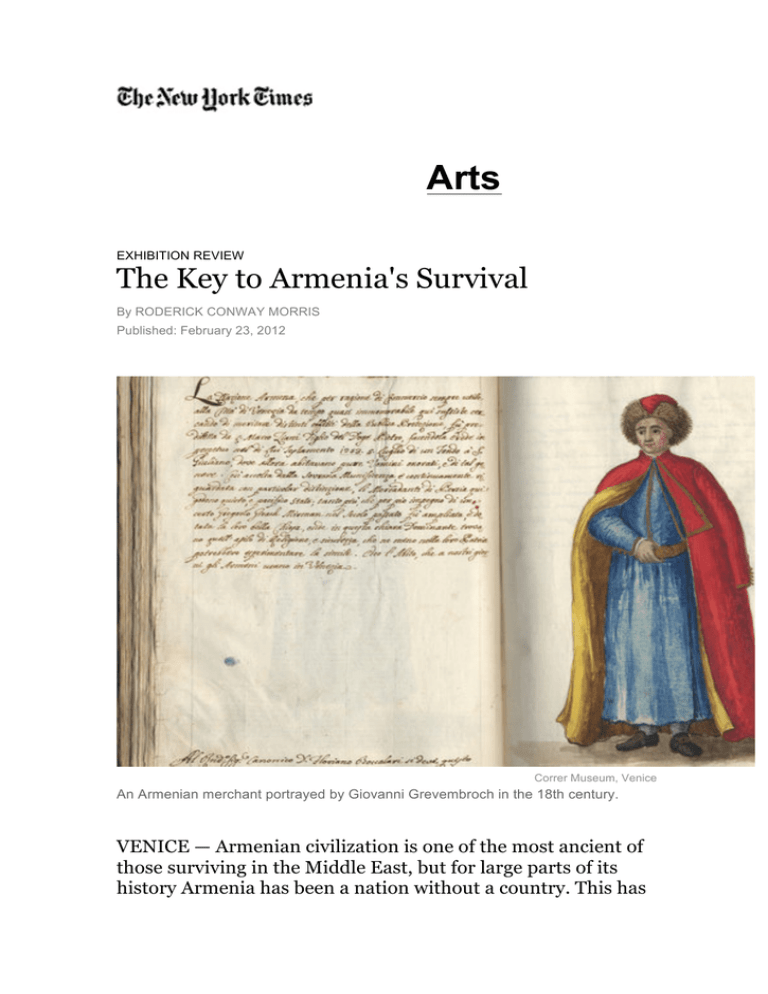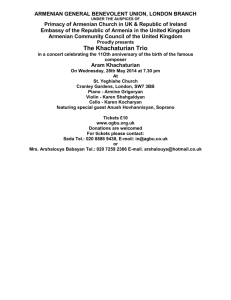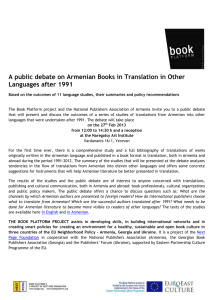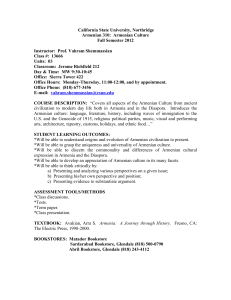Arts The Key to Armenia's Survival
advertisement

Arts EXHIBITION REVIEW The Key to Armenia's Survival By RODERICK CONWAY MORRIS Published: February 23, 2012 Correr Museum, Venice An Armenian merchant portrayed by Giovanni Grevembroch in the 18th century. VENICE — Armenian civilization is one of the most ancient of those surviving in the Middle East, but for large parts of its history Armenia has been a nation without a country. This has given the spoken and written word, the primary means through which Armenian identity has been preserved, enormous prominence in its people’s culture. Enlarge This Image Library of the Mekhitarist Fathers, San Lazzaro A gospel dating from 1331 with an illumination of St. Matthew with the artist himself, Sargiz Pitzak, kneeling at the feet of the evangelist. Enlarge This Image Zvartnots Cathedral Museum, Echmiadzin A 7th-century sundial with Armenian numbers from Zvartnots Cathedral in Echmiadzin, Armenia. Over the centuries this emphasis has fostered a particular regard for books and the means of producing them. Scribes added notes on the proper care and conservation of books and advice on hiding them during dangerous times, even on “ransoming” them should they fall into the wrong hands. A late 19th-century English traveler observed that the Armenians prized the printing press with the same “affection and reverence as the Persian highlanders value a rifle or sporting gun.” In 1511 to 1512 (the exact date is uncertain), the first Armenian book was printed in Venice. The event was especially significant for this scattered nation, which did not acquire a modern homeland until 1918 and then only in a small part of its ancestral lands. The anniversary is the occasion for “Armenia: Imprints of a Civilization,” an impressive exhibition organized by Gabriella Ulluhogian, Boghos Levon Zekiyan and Vartan Karapetian of more than 200 works spanning more than 1,000 years of Armenian written culture. These range from inscriptions and illuminated manuscripts to printed and illustrated books, including many unique and rare pieces from collections in Armenia and Europe. The show opens with the atmospheric painting of 1889 by the Armenian artist Ivan Aivazovski, “The Descent of Noah From Mount Ararat,” from the National Gallery in Yerevan. It shows the Old Testament patriarch leading his family and a procession of animals across the plain, still watery from the subsiding Flood, to re-people the earth. The extraordinary grip that this mountain has had on the Armenian imagination is tellingly demonstrated by subsequent sections on sculpture, the Armenian Church and the Ark — the conical domes of Armenian churches seeming eternally to replicate this geographical feature that symbolizes the salvation of the human race. Christianity reached Armenia as early as the first or early second century. And Armenia lays claim to having been the first nation that adopted the faith as a state religion, sometime between 293 and 314, a date traditionally recorded by the Armenian Church as 301. There followed, in around 404 or 405, an initiative that has been one of the cornerstones of the endurance of the Armenian ethnos: the invention of a distinctive alphabet capable of rendering the language’s complex phonetic system. This made possible the translation of the Bible — the majestic 10thcentury Gospel of Trebizond is on show here — and the foundation of Armenian literature in all its manifestations, sacred and secular. The desire to illustrate the gospels and other Christian texts was the primary impetus for the development of Armenian art, which drew on an unusually wide range of sources thanks to the country’s position at the crossroads of several civilizations. As Dickran Kouymjian writes in his essay in the exhibition’s substantial and wide-ranging catalog, which is available in English, French and Italian: “Armenian artists were remarkably open to artistic trends in Byzantium, the Latin West, the Islamic Near East and even Central Asia and China.” A sumptuous display of these illuminated books brings together some of the finest surviving examples from the ninth to the 15th centuries, and it is curious to discover that even after the advent of printing, the tradition of illumination continued in Armenian monasteries for a further two and a half centuries. The acme of the Armenian miniature was reached in the 13th century, during the Armenian Kingdom of Cilicia, which ruled over a substantial part of Asia Minor (1198-1375), until it was overthrown by the Mamluks of Egypt. Armenian contacts with Venice date to the period when the nascent lagoon republic was a remote western outpost of Byzantium, where Armenians held senior positions in the administration and the military. In the sixth century the Armenian governor Narses is credited with introducing the cult of Theodore, or Todoro, Venice’s first patron saint and Isaac the Armenian is recorded as the founder of the ancient Santa Maria Assunta basilica on the island of Torcello. Contacts became frequent during the Kingdom of Cilicia as Venetian merchants expanded their activities in the Levant and their Armenian counterparts sought opportunities in Europe. In 1235 the Venetian nobleman Marco Ziani left a house to the Armenian community at San Zulian near Piazza San Marco, which came to be called the Casa Armena and provided a focal point for Venice’s ever more numerous Armenian residents and visitors. The testament drawn up in 1354 by the governess of this house, “Maria the Armenian,” indicates that by that time there was not only a thriving community of merchants, but also clerics and an archbishop, to whom she left three of her six peacocks. Later the church of Santa Croce was founded on the same site, still today an Armenian place of worship. Both Marco Ziani and Maria’s wills are on show. A precious copy of the first Armenian book printed in 15111512, a religious work titled the Book of Friday, is also on display. The innovation led to the setting up of a host of Armenian presses all over the world. The fruits of these — from locations as far-flung as Amsterdam, Paris, Vienna and St. Petersburg to Istanbul, Isfahan, Madras and Singapore — form the absorbing last section of the exhibition. Venice was given a further boost as the global center of Armenian culture by the arrival in the lagoon of Abbot Mekhitar and his monks in 1715. This visionary was born in Sivas (ancient Sebastia) in Anatolia, and had spent time in Echmiadzin and Istanbul. Later he took the community he had created to Methoni in the Peloponnese, which had been conquered by the Venetians in the 1680s. But the prospect of the town’s recapture by the Ottomans led to Mekhitar’s decision to take refuge in Venice. In 1717 he and his followers were granted a lease on the island of San Lazzaro, which has been their headquarters ever since. Under Mekhitar, San Lazzaro became the epicenter of a worldwide Armenian cultural revival. The community created a study center and library, was responsible for printing scores of books in Venice and elsewhere, and established an international network of schools, where a high proportion of Armenia’s religious and secular elite received an education into modern times. The Armenian Academy of San Lazzaro has published Bazmavep, a literary, historical and scientific journal since 1843, one of the oldest continuous periodicals of its kind. And the first Armenian newspaper-magazine was Azdara (The Monitor), founded in Madras in 1794. San Lazzaro’s most famous foreign student was Lord Byron, who learned Armenian there with the scholar Harutiun Avgerian, with whom he collaborated on the production of an Armenian and English grammar, containing translations by the poet. Armenia: Imprints of a Civilization. Correr Museum, Venice.Through April 10. A version of this article appeared in print on February 24, 2012, in The International Herald Tribune. http://www.nytimes.com/2012/02/24/arts/24iht-­‐conway24.html


